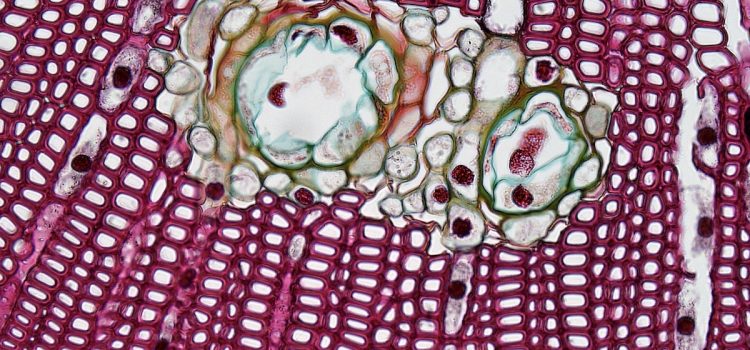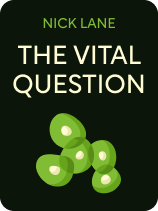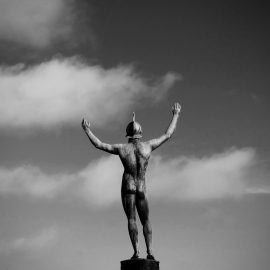

This article is an excerpt from the Shortform book guide to "The Vital Question" by Nick Lane. Shortform has the world's best summaries and analyses of books you should be reading.
Like this article? Sign up for a free trial here.
What is life? How does life work? Can organization and complexity arise from chaos?
Biochemist Nick Lane answers these questions as a starting point in his exploration of life’s origins. He says that, to explain the origin of life, we have to understand how cells process energy and the physical conditions that gave rise to the peculiar mechanisms that all life uses to power itself.
Read more for Lane’s explanation of how life works.
How Does Life Work?
What is life? How does life work? Lane says that, in its simplest form, life is a process by which matter self-organizes into complex, self-replicating molecules—a process that can only sustain itself with a continual flow of energy. That energy allows living systems to avoid decomposing long enough to reproduce, creating an internal electrical voltage to power microscopic molecular machines that use carbon atoms as their basic building blocks.
In our everyday experience, disorganized matter doesn’t spontaneously arrange itself into complex forms, any more than a pile of bricks can turn into a house without outside help. Yet, at first glance, it seems that life does this, especially when it comes to its origin. Not only can it seem unlikely that organization can arise from chaos, but doing so might be viewed as violating the laws of thermodynamics—which is why those laws must be clearly understood.
The second law of thermodynamics states that, in any given system, entropy—the amount of chaos and disorder—will increase over time. However, living things seem to contradict this by growing, reproducing, and evolving into ever more complex, well-ordered systems of biochemical processes and molecular machines that have functioned for billions of years. Lane points out that this doesn’t violate the laws of physics. Life only decreases entropy in the short term, and it does so by increasing entropy around it—consuming its surrounding environment for fuel while expelling disorganized matter and energy as waste and heat.
| Creationism Versus Thermodynamics Though Lane never questions whether the theory of evolution is true, creationists have often cited the second law of thermodynamics as evidence against evolution. In particular, the creationist argument centers around a phrasing of the second law that equates entropy with disorder and states that order cannot increase in any natural, physical system. Scientists point out that this statement relies on a misreading of the second law. The law states that entropy must increase in an isolated system in which matter and energy cannot enter or escape. However, our biosphere is an open system in that it receives a constant flow of energy—light from the sun, heat and matter from the earth’s interior, and the constant tidal push and pull on the oceans from the gravitational attraction of the moon. Our planet is also an open thermodynamic system because it emits energy back into space in the form of infrared light. Within the boundaries of an open system, order can increase so long as the energy output of the system is greater than the energy input. An example of this is crystal growth, in which changes in temperature and pressure make disordered atoms link together in orderly, matrix-like structures. The origination of life from nonliving matter follows a similar process. |
This constant flow of energy from the outside world enables the order and complexity of life. What’s striking to Lane is the roundabout method life takes to facilitate this flow. In every living cell, an electrical voltage across a narrow membrane drives the production of a molecule called adenosine triphosphate (ATP), the fundamental unit of fuel that life uses. A typical cell “burns” ATP at a rate of 10 million molecules per second, and that ATP must be constantly replenished via cellular respiration—in which oxygen reacts with the chemical building blocks cells take from food, including carbon, nitrogen, hydrogen, and phosphorus.
(Shortform note: The process Lane describes in which the body produces ATP and uses it to fuel biological functions was established in the 1940s by Fritz Lipmann, who would win the Nobel Prize for his discovery of acetyl coenzyme A, a crucial tool the body uses to convert fatty acids into ATP, as well as to metabolize carbs and protein. The process of releasing energy from ATP is actually a form of combustion, though, unlike the all-at-once combustion of burning wood or gasoline, the combustion reactions inside your cells are broken down into several discrete steps that release a fraction of the total energy that the entire process produces. The amount of ATP your cells make and burn every day is equivalent to the total mass of your body.)
The Engine of the Cell
Lane explains that, within our cells are microscopic power plants known as mitochondria. Inside the mitochondria, various proteins rip hydrogen atoms out of food molecules, separating their protons and sending their electrons down a chain of oxygen atoms like a current down a wire. Each electron stop along the oxygen chain triggers a piece of protein machinery that shuttles a free proton across the inner mitochondrial membrane. The buildup of protons (and thus a positive charge) on one side of the membrane creates a strong electrical voltage, proportional in strength to a blast of lightning across the mitochondria’s infinitesimal space.
(Shortform note: The electrical power that Lane’s discussing originates from one of the four fundamental forces of nature—specifically, the electromagnetic force that attracts particles with opposite electrical charges and repels those that have the same charge. This force strives to bring protons and electrons together, so when the cell’s proteins force them apart onto opposite sides of a membrane, it creates a great deal of potential energy like water held back by a dam.)
This electrochemical gradient powers the creation of ATP. What Lane finds particularly odd is that ATP synthesis isn’t a chemical reaction. It’s a physical construction process of atoms being assembled into molecules by protein machines running on electrical power. There’s no obvious evolutionary reasoning behind how microscopic yet powerful electrochemical gradients could have developed through random genetic trial and error, and yet these gradients are found in all life, even simple bacteria without mitochondria. The fact that they’re shared by all living beings implies that electrochemical gradients were a feature of life from the very beginning.
(Shortform note: A fundamental precept of evolution that Lane returns to time and time again is that when different species share a common trait—such as four limbs with similar joints—it means that trait was inherited from a common ancestor. Charles Darwin himself introduced this idea in On the Origin of Species when he discussed how modern species are related. When looking at how evolution progresses, we can trace how changes in traits create new species. When winding the evolutionary clock backward, it follows that any trait common to every branch of life must have been developed before those branches separated from each other.)
For Lane, life’s underlying chemical reaction is easy to understand. At its most basic, life runs on the transfer of electrons from hydrogen to carbon dioxide, both of which are common throughout the universe. Hydrogen and oxygen are soluble, stable, and ideal as donors and receptors of electrons, whereas the carbon in carbon dioxide is a perfect building block capable of forming long and complex molecular chains such as proteins, lipids, and even DNA.
Nevertheless, when Lane considers the commonalities among the three different branches of life—single-celled bacteria; their cousins, the archaea; and complex, multicellular eukaryotes such as plants, animals, slime molds, and ourselves—he finds vast differences in many of the most basic functions of life, even in the way DNA reproduces. From this, he deduces that our remote common ancestor, the life form from which all other life descended, was barely a cell at all in the common sense.
| The Birth of DNA One facet of cellular evolution that Lane doesn’t cover is the origin of the DNA molecule. DNA (deoxyribonucleic acid) is the molecular chain that carries the genetic blueprint for life that’s found inside every cell. It’s composed of four basic organic molecules called nucleotides arranged in a double-helix structure. DNA’s blueprints are “decoded” by enzymes (proteins that facilitate chemical reactions) into molecular messages that govern the rest of the cell’s functions, including making copies of DNA to pass on to the cell’s offspring. For decades, scientists have worked to explain how DNA and its simpler cousin RNA might have originated by reproducing the process in a lab to see if the organic compounds present in the early oceans could polymerize into self-replicating strands. For a long time, biologists assumed that RNA formed first and DNA came later, but more recent studies have shown that DNA and RNA probably developed at the same time and that, if they did, the interaction between the two might explain how DNA evolved its method of copying itself. |

———End of Preview———
Like what you just read? Read the rest of the world's best book summary and analysis of Nick Lane's "The Vital Question" at Shortform.
Here's what you'll find in our full The Vital Question summary:
- Why genetics alone aren't enough to explain why cells function as they do
- A theory on where all complex life originated from
- An explanation of how cells work and are made






